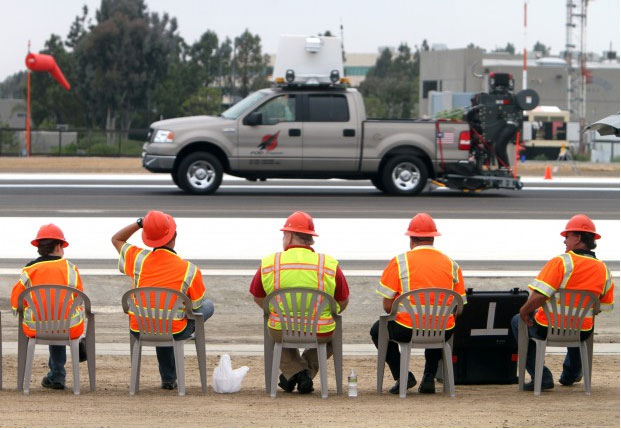News Articles
 |
June 11, 2010
Tech: Local Firm Hunts Dangerous Debris on Runway
Carlsbad airport scene of safety testing
By BRADLEY J. FIKES - [email protected] | Posted: June 11, 2010
 |
||
|
A team of scientists and engineers from Trex Enterprises and the University of Illinois watch as Trex tests a radar device mounted on a pickup while on the runway at McClellan-Palomar Airport in Carlsbad on Tuesday. The purpose of the device is to locate and pick up small pieces of debris that damage aircraft during take-offs and landings. (Photo by Hayne Palmour IV - Staff photographer) | |
CARLSBAD ---- Stumble over a rock or a piece of junk on the sidewalk, and you might fall. But if an aircraft hits such debris, the consequences can be far more serious ---- the 2000 fatal crash of the supersonic Concorde jet in Paris was blamed on metal lying on a runway. So airport employees regularly inspect the runways to make sure they're clear of such debris. San Diego-based Trex Enterprises Corp. says it offers a better way than the human eye to find and remove this dangerous junk.
They've adapted a military technology that uses millimeter-length radio waves to identify what the aviation industry calls "foreign object debris," and then remove it. Trex is testing its system at McClellan-Palomar Airport. This week, officials from the Federal Aviation Administration dropped by to see the system in action. By tracking and removing debris that can damage aircraft, Trex's system can improve safety and lower aircraft insurance rates, said Grant Bishop, chief operations officer of Trex Aviation Corp., a subsidiary of the company.
Called FOD Finder, the truck-mounted system not only locates the debris, but also vacuums it up, Bishop said. The waves have one-tenth the energy of a cell phone's radiation, he said. The military uses this technology to detect such obstacles as wires in the air that could entangle helicopters, said Bishop, a former commander of the U.S. Air Force's 4th Fighter Squadron. Bishop flew F-16s and served in Operation Iraqi Freedom in 2003.
On the ground, the debris threatening aircraft can be just about anything ---- lost tools, pavement fragments, gas caps or broken aircraft parts. For example, the Concorde passenger jet crash, which killed all 109 people on board, was caused by a metal strip that had fallen from another aircraft, according to a French investigation. Willie Vasquez, manager of Palomar Airport, said he's impressed with what he has seen of Trex's system. Large airports such as Los Angeles International Airport are most in need of improved debris detection, he said. "They (LAX) probably do 10 inspections a day," Vasquez said. "Right now, it's all done by the human eye, and these guys don't have a lot of time in between all the flights. But this thing doesn't get tired. It doesn't matter whether it's day or night." Trex has been testing its system at Palomar Airport for months before the FAA visit this week to verify its accuracy, Bishop said. The airport is convenient and logistically easier to work from than the far-busier San Diego International Airport. Meanwhile, McClellan-Palomar is completing major upgrades visible to anyone who hasn't been to the airport recently. These include a new building housing a gate for a startup service, California Pacific Airlines, preparing to begin operations as early as November. Vasquez said he's showing the airport's upgrades to other potential customers. On Tuesday morning, for example, he hosted a visit from Frontier Airlines.
Improved safety from Trex's system, which costs $400,000, can make the airport even more desirable, Bishop said.
If Palomar Airport buys it, "they're going to have one of the most advanced systems out here, saving people money and keeping them safe." The FAA is testing three other types of detection systems, but Trex's is the only one made in the United States, Bishop said. The others are made by companies in Britain, Israel and Singapore. Edwin E. Herricks, leader of the FAA's performance assessment, said the others are based in fixed locations, at a tower, and scan the runways from the tower. Trex's FOD Finder is the only mobile system being tested. The agency's assessment should be done by the fall, said Herricks, coordinator of airport safety management at the Center for Excellence for Airport Technology at the University of Illinois at Urbana-Champaign.
Airports can then decide which debris-detection system to buy. The agency has left the decision up to each airport.
Trex also makes fixed-base and transportable FOD detectors, Bishop said. The transportable system is similar to the fixed system, but can be moved from one location to another. Airports aren't being told which system to choose, Bishop said, but the FAA has a "buy-American" policy, including financial incentives.
Contact Trex Enterprises at www.trexenterprises.com or call 858-646-5553.
Call staff writer Bradley J. Fikes at 760-739-6641.
Read his blogs at bizblogs.nctimes.com.